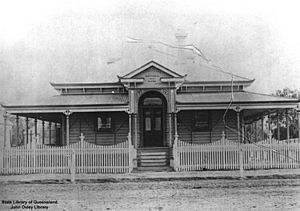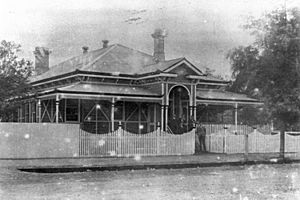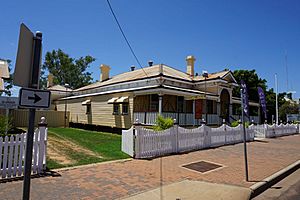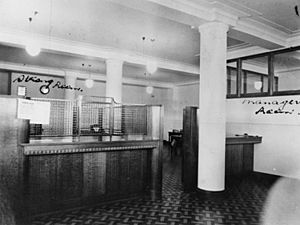Queensland National Bank, Charleville facts for kids
Quick facts for kids Queensland National Bank, Charleville |
|
|---|---|
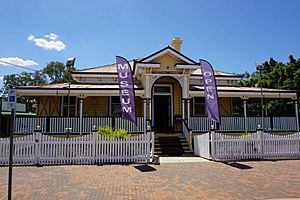
Queensland National Bank (now museum), Charleville, 2017
|
|
| Location | 87 Alfred Street, Charleville, Shire of Murweh, Queensland, Australia |
| Design period | 1870s–1890s (late 19th century) |
| Built | 1888 |
| Built for | Queensland National Bank |
| Architect | Francis Drummond Greville Stanley |
| Official name: Queensland National Bank (former), 'Historic House | |
| Type | state heritage (built) |
| Designated | 21 October 1992 |
| Reference no. | 600757 |
| Significant period | 1880s (fabric) 1888–1942 (historical use) |
| Significant components | residential accommodation – manager's house/quarters, fireplace |
| Builders | A Anderson |
| Lua error in Module:Location_map at line 420: attempt to index field 'wikibase' (a nil value). | |
The Queensland National Bank building in Charleville is a very old and important building. It used to be a bank, but now it's a museum called the Historic House Museum. It's located at 87 Alfred Street in Charleville, Queensland, Australia. A famous architect named Francis Drummond Greville Stanley designed it, and it was built in 1888 by A Anderson. This building is so special that it was added to the Queensland Heritage Register on October 21, 1992. This means it's protected because of its history and unique features.
Contents
A Look Back in Time
The Queensland National Bank building was built in Charleville in 1888. It was made to be the local office for the Queensland National Bank. This bank had first opened a branch in Charleville in 1881.
Charleville's Growth
The town of Charleville was planned out in 1867. It was built along the Warrego River, which was a path for moving farm animals from New South Wales to Western Queensland. Charleville quickly became a main hub for the farming industry around it.
- Big teams of bullocks (oxen) passed through the town.
- Cobb and Co, a famous coach company, set up stables and even a factory there. They built mail coaches and buggies.
- In 1888, Charleville became even more important for transport. It was the end point for the main Western railway line. This railway later extended further south and west.
The Queensland National Bank was the very first bank to open in Charleville. It started its business there on July 30, 1881.
The Queensland National Bank Story
The Queensland National Bank was the first and most successful bank started in Queensland during the 1800s. It began in March 1872. A group of important people, like farmers, politicians, and lawyers, started it. They wanted to help Queensland grow using money from within the state.
The bank's first office was in Queen Street, Brisbane. Many people in Queensland chose to bank with them. By 1879, the bank handled all the money for the Queensland Government. By 1880, it held 40% of all the money saved in the colony. It was a very powerful bank in Queensland's economy.
Building the Bank
In 1888, a bigger bank building was needed in Charleville. Francis Drummond Greville Stanley designed this new building. A Anderson built it for about £2049.
Stanley was an architect who trained in Scotland. He moved to Queensland in 1861. He worked for the Queensland Government Architect and became the main Colonial Architect in 1872. He later started his own private business. He designed buildings for many banks, churches, and companies. Stanley was one of the most successful architects in Queensland in the 1800s.
Some of his other famous works include:
- The General Post Office in Brisbane.
- St Paul's Anglican Church in Maryborough.
- The Queensland Club in Brisbane.
Stanley also designed other timber bank buildings for the Queensland National Bank in towns like St George and Blackall.
The Charleville bank building was special because it had both the bank's business area and a home for the bank manager. This was common for bank branches in smaller towns back then. The front part of the building had a public area for customers, a teller's counter, and a safe. There was also an office for the manager. The back part of the building was where the manager and his family lived. It even had a room for their maid. This shows how important a bank manager was in a regional town.
New Chapters for the Building
In 1942, the Charleville bank branch was sold. This might have happened because of changes during World War II. Mr. Alex Smith bought it and lived there for many years. In 1948, the Queensland National Bank joined with another bank, which later became the National Australia Bank.
After Mr. Smith passed away, his daughter, Mrs. Claude Young, turned the building into a boarding house. A boarding house is like a small hotel where people can rent rooms. When Mrs. Young died, the Charleville and District Cultural and Historical Society bought the building. Today, it is a local history museum, where people can learn about the town's past.
What the Building Looks Like
The former Queensland National Bank in Charleville is a single-story building made of timber. You can see the wooden frame on the outside. It sits on low stumps, which helps protect it from moisture. The roof is a hipped roof covered with corrugated iron.
There are verandahs (covered porches) at the front and sides of the building. These verandahs have a corrugated iron roof supported by wooden posts. A central part of the building sticks out at the front, marking the entrance. You reach it by climbing timber steps.
Inside, the building has high ceilings and beautiful cedar wood details. There are also four fireplaces made of marble. Some of the rooms inside are set up like a museum, showing how they might have looked in the past.
Outside, there is a picket fence along the street.
Why It's a Heritage Site
The former Queensland National Bank in Charleville was added to the Queensland Heritage Register on October 21, 1992. This means it's considered a very important historical place. Here's why:
Showing Queensland's History
This building helps us understand how Queensland grew. It was built specifically for a bank that was created to help Queensland's own people and businesses. The excellent design and strong construction show how important this regional bank was. It was built when Charleville was a key center for farming in southwest Queensland.
A Great Example of a Bank Building
The former Queensland National Bank is a good example of what a regional bank looked like back then. It's a timber building that combined a banking area, an office, and a home for the manager. This type of building was very common for banks in country areas from the 1800s until World War II.
Beautiful Design
This building is well-designed and detailed. It adds to the beauty of Charleville town.
Connected to Important People and Groups
The building is linked to the famous architect F.D.G. Stanley, who designed many banks for the Queensland National Bank. It's also connected to the Queensland National Bank itself, which was the first bank started by people in Queensland.


